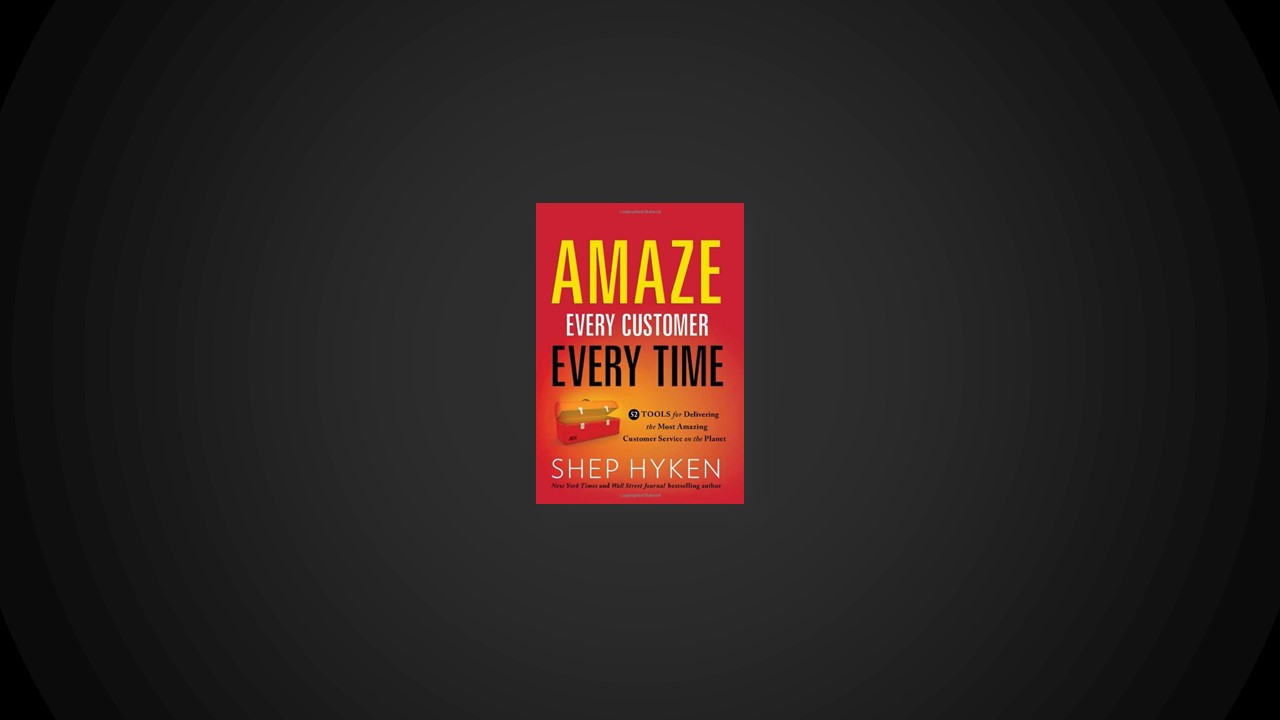Amazement is the level of customer experience that gives you a clear advantage in any economy and any marketplace. Amazement is the competitive edge that separates good companies from truly great companies. And believe it or not, an amazing customer experience is well within your capacity to deliver to every customer, every single time.
Amazement is the advantage that makes the competition start thinking about how “unfair” it is to have to be operating in the same market, the same planet, the same dimension as you do.
Amazement is what makes it easy for you to stand out and win repeat business, create customer evangelists, and reap referrals—whether times are good or bad; whether your company sells ballpoint pens, ball bearings, or ballroom dancing lessons; whether your customers are consumers, businesses, or both.
Amazement is what the “best of the best” companies have figured out. And it’s what you can figure out too. These companies know that no matter how great their product or service, they can’t expect to get and keep customers if they don’t deliver an amazing experience. Guess what! You can’t either.
The Seven Amazement Principles
PRINCIPLE #1: THE MOMENT OF MAGIC
Have you ever gotten service that was so outstanding that you promised yourself you’d go back and buy from the same place so you could enjoy the experience all over again?
Maybe you were in a restaurant, and you found the service and food so outstanding that you left an extra-large tip. Or maybe you were in a hotel where all the staff seemed courteous and helpful, and truly made you feel like a VIP. Or maybe, just maybe, you went to a local hardware store, perhaps without even realizing what the name of the store was, and suddenly found yourself treated like a member of the family.
Once you have been treated to a moment like this, you feel extra satisfaction, knowing that someone (or a company) has gone the extra mile to serve you. No matter what business or occupation you are in, you can use the Moments of Magic concept to achieve greater success. When you consistently create Moments of Magic, your customers will want to do business with you again and again—and will tell all their friends to do business with you. Without Moments of Magic, you cannot possibly amaze your customers!
PRINCIPLE #2: THE MOMENT OF TRUTH
Now we know: A Moment of Magic is what happens when you receive above-average service. A Moment of Truth is the opportunity to make that Moment of Magic happen—an opportunity that some companies take full advantage of, and other companies don’t.
Each and every interaction we have with a customer, be it person-to-person or online, is a Moment of Truth. At that moment, we have the chance to leave a positive or a negative feeling with the customer about the experience. That feeling we leave with the customer can make or break our business.
Jan Carlzon, the author of the book Moments of Truth (Ballinger, 1987), who was the former president of Scandinavian Airlines, better known as SAS defined the Moment of Truth like this:
Any time a customer comes into contact with any aspect of your business, however remote, they have an opportunity to form an impression.
Carlzon identified a number of particularly critical Moments of Truth for his airline. These included:
- When passengers make reservations;
- At the curb when they check their bags;
- At the ticket counter when they purchase or confirm their tickets;
- When they are greeted as they board the plane;
- When they are greeted at their destination; and
- At the baggage claim area when they pick up their bags.
Of course, there are many other Moments of Truth that can happen in between these experiences. A passenger might be walking down the concourse toward the gate and might pass an employee of the airline. If that employee smiles, that might be a positive Moment of Truth. It’s not a main Moment of Truth, but it is still a very important one. Remember that every Moment of Truth, even the smallest interaction, is an opportunity for a customer to form an opinion or impression of the company.
PRINCIPLE #3: THE MOMENT OF MISERY
A Moment of Misery is what happens when a Moment of Truth is mis-handled. Unfortunately, this is an all too common experience. If you’ve ever found yourself waiting too long for the server at the restaurant to notice you, or gotten an alarmingly large bill you couldn’t make sense of from an auto repair shop, you’ve experienced a Moment of Misery. Notice again that it doesn’t have to be extreme. This can be a major complaint or problem or just a below-average experience.
Any Moment of Truth can go well—or go poorly. Even great service companies have their share of Moments of Misery. No one person, no company, is perfect. And the great companies recognize this, but they also know that Moments of Misery can be turned into Moments of Magic. They have trained their people and have systems in place to deal with complaints and problems. It is all in the “recovery.”
Our job is to take any Moment of Misery, seize it as an opportunity to create a Moment of Magic, and show how good we are!
PRINCIPLE #4: THE MOMENT OF MEDIOCRITY
According to Jan Carlzon, the Moment of Truth can go two ways: good or bad.
A Moment of Truth that is just average is a Moment of Mediocrity. It’s neither bad nor good. It’s just okay. Satisfactory. Nothing special.
In other words, not particularly bad or good, just satisfactory. Are you going to be excited about spending your hard-earned money at a restaurant that is just “okay”? If you do decide to eat there (maybe you’re short on time), are you going to go out of your way to tell other people about it? Probably not.
That average, nothing-special Moment of Mediocrity is what too many companies deliver. Even if the customer comes back, at any given time the customer may realize that there is a better place to do business, and most likely will quietly switch to a competitor.
PRINCIPLE #5: CUSTOMER AMAZEMENT
This is what this book is all about: Amazing Every Customer Every Time! That’s a lofty goal—but a very achievable goal.
It starts with managing the Moment of Truth and creating Moments of Magic. That means that you have a goal that each and every interaction you have with the customer has to be better than average. Just a little better than average!
It may be as simple as the way you smile and greet someone when they walk through your doors or into your office. Or it may be the amazing experience you create when you really do go above and beyond what is expected. The goal is that every seemingly insignificant interaction, as well as the biggest experience, needs to be better than average.
Amazing companies don’t just deliver Moments of Magic. They consistently and predictably deliver Moments of Magic. While it is easy for anyone or any company to be above average some of the time, it is the great ones that are above average all of the time. And that is what amazement is: consistently and predictably better than average.
PRINCIPLE #6: INTERNAL AND EXTERNAL CUSTOMERS
“I don’t deal directly with the public, so my job doesn’t involve customer service.”
Wrong!
To understand why this is so, you must understand that there are really two types of customers: internal and external. The external customer is the buyer of your company’s product or service. You also have many internal customers. These are the people who don’t interact directly with the customer but who do affect the external customer experience. In the final analysis, of course, everything everyone in your company does affects the external customer experience. We have to amaze our internal customers if we want our external customers to be amazed!
You may be familiar with the term “customer-centric.” This describes a company that operates on the principle that everyone who works for the company, and every responsibility assigned within it, should put the customer first. Everyone, everywhere, should put the customer at the “top-of-mind” level. How does a company become customer-centric? By recognizing the importance of internal service.
PRINCIPLE #7: THE FIVE STAGES
As we have just seen, some companies choose to amaze their customers first. There are some companies that create a powerful “brand promise” that works internally/externally. If you want your company to Amaze Every Customer Every Time, you want to be this kind of company. That means everyone in the company must move through five distinct stages (referred to as “Cults” in the book The Cult of the Customer [Wiley, 2009]) in relation to that brand promise on their way to experiencing amazement. Those stages are:
Uncertainty: The employee, also known as the internal customer, is not yet aware or convinced that the brand promise even exists or can be fulfilled.
Alignment: The employee understands what the brand promise is.
Experience: The employee experiences the brand promise and likes the results.
Ownership: The employee experiences the brand promise enough to be confident that it will happen the next time—and every time.
Amazement: The experience that the employee owns is consistently above average. As a result, he or she becomes an advocate and evangelist for promoting and fulfilling the brand promise.
Just as the employees go through these stages, customers go through the exact same ones. The first time customers do business with an organization they are uncertain, but hoping, that it will be a good experience. They may understand the brand promise, which means they are in alignment with the company, but they haven’t yet experienced it. Once they have experienced the promise, and they are confident it will happen again, they have ownership of the brand promise. And, if that experience is consistently better than average, they have been treated to customer amazement.
Only when an internal customer has gone through these five stages can he or she be expected to lead a customer through them!
It might not seem obvious at first, but once you think about it, you realize that truly great service companies are always employee-centric before they are customer-centric. One of the most important lessons you will learn in this book is that, in order to create a customer-centric company, you must first create an employee-centric company. What’s happening on the inside of an organization is always being felt on the outside by its customers.


